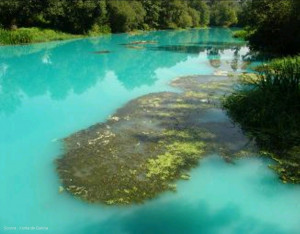At 2.30 pm, a fire broke out during the unloading of a toluene road tanker at a chemical plant close to the coast. Two homes nearby and several warehouses in the industrial area were evacuated and the civil protection advised resident populations to stay inside. Firefighters, the civil protection and the police intervened.
The fibreglass tanks containing chemical substances and water did not withstand the intense heat that developed during the fire and collapsed. As the capacity of the retention basins was insufficient for containing the chemicals/fire extinguishing water mixture, 150,000 L of chemicals (toluene, xylene, styrene, heavy metals, etc.) including a proportion stored in drums and bags on the ground, spilled into the nearby UMIA river. A turquoise slick of approximately 3 km then slowly moved (100 m/h) towards the Atlantic killing all of the fauna and flora in its passage: 7 km of river were affected.
The next day, domestic use of the river water was prohibited for 80,000 inhabitants in 9 municipalities. The regional government also preventively closed 2 shellfish beds located at the mouth of the UMIA river; they were reopened two days later after checking that there was no contamination.
Significant work was then carried out rapidly to resupply the population with water and prevent pollution of the Atlantic and shellfish beds at the mouth of the river:
- installation of 20 km of safe drinking water pipes to be connected to a pumping station;
- construction of 4 tailing dams to divert the contaminated water towards 3 purification basins;
- treatment of the water using activated carbon filters (40 t), magnesium hydroxide, calcium hydroxide, gravel and sand filters, as well as a forced aeration system;
- fishing of the fish that were still alive and transfer to uncontaminated water.
A few days after the discharge (on 07/09), analyses of the water samples collected on a daily basis in the watercourse no longer showed anomalies (water and surviving fish). Two dikes were opened around ten days after the fire, allowing “normal” resupply of the water in the 9 municipalities affected.
No one was injured, but a large part of the storage area was destroyed. This accident caused gas (48 hours), electricity (24 hours), water (15 days), and telecommunications (6 hours) to be cut off. The costs were estimated at 3.4 million euros for equipment, 1.6 million euros for cleaning and restoration, and 8 million euros for other costs. The operator, by agreement before the process, also paid 5.5 million euros of compensation to the region. The plant was dismantled and the operator set up on another site in a less sensitive area.
The cause of the fire was not clear; 3 causes (or combination of the 3) were considered:
- a spark due to static electricity which would have caused the toluene to catch fire during unloading;
- high temperatures;
- the friction of the toluene against the container in which it was unloaded.
The Spanish authorities finally highlighted that the use of foam could have limited the amount of water used.




